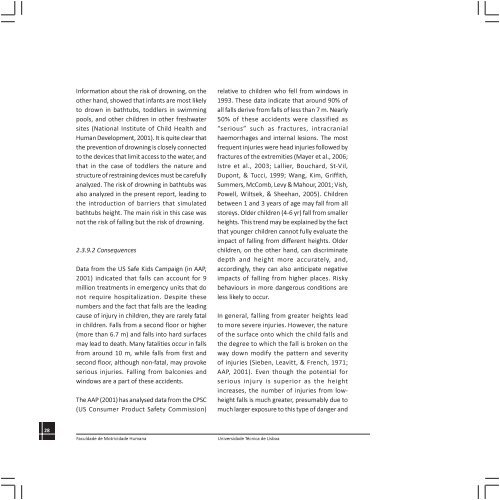Dimensions and Design of swimming pool fences and balcony - ANEC
Dimensions and Design of swimming pool fences and balcony - ANEC
Dimensions and Design of swimming pool fences and balcony - ANEC
Create successful ePaper yourself
Turn your PDF publications into a flip-book with our unique Google optimized e-Paper software.
Information about the risk <strong>of</strong> drowning, on the<br />
other h<strong>and</strong>, showed that infants are most likely<br />
to drown in bathtubs, toddlers in <strong>swimming</strong><br />
<strong>pool</strong>s, <strong>and</strong> other children in other freshwater<br />
sites (National Institute <strong>of</strong> Child Health <strong>and</strong><br />
Human Development, 2001). It is quite clear that<br />
the prevention <strong>of</strong> drowning is closely connected<br />
to the devices that limit access to the water, <strong>and</strong><br />
that in the case <strong>of</strong> toddlers the nature <strong>and</strong><br />
structure <strong>of</strong> restraining devices must be carefully<br />
analyzed. The risk <strong>of</strong> drowning in bathtubs was<br />
also analyzed in the present report, leading to<br />
the introduction <strong>of</strong> barriers that simulated<br />
bathtubs height. The main risk in this case was<br />
not the risk <strong>of</strong> falling but the risk <strong>of</strong> drowning.<br />
2.3.9.2 Consequences<br />
Data from the US Safe Kids Campaign (in AAP,<br />
2001) indicated that falls can account for 9<br />
million treatments in emergency units that do<br />
not require hospitalization. Despite these<br />
numbers <strong>and</strong> the fact that falls are the leading<br />
cause <strong>of</strong> injury in children, they are rarely fatal<br />
in children. Falls from a second floor or higher<br />
(more than 6.7 m) <strong>and</strong> falls into hard surfaces<br />
may lead to death. Many fatalities occur in falls<br />
from around 10 m, while falls from first <strong>and</strong><br />
second floor, although non-fatal, may provoke<br />
serious injuries. Falling from balconies <strong>and</strong><br />
windows are a part <strong>of</strong> these accidents.<br />
The AAP (2001) has analysed data from the CPSC<br />
(US Consumer Product Safety Commission)<br />
relative to children who fell from windows in<br />
1993. These data indicate that around 90% <strong>of</strong><br />
all falls derive from falls <strong>of</strong> less than 7 m. Nearly<br />
50% <strong>of</strong> these accidents were classified as<br />
“serious” such as fractures, intracranial<br />
haemorrhages <strong>and</strong> internal lesions. The most<br />
frequent injuries were head injuries followed by<br />
fractures <strong>of</strong> the extremities (Mayer et al., 2006;<br />
Istre et al., 2003; Lallier, Bouchard, St-Vil,<br />
Dupont, & Tucci, 1999; Wang, Kim, Griffith,<br />
Summers, McComb, Levy & Mahour, 2001; Vish,<br />
Powell, Wiltsek, & Sheehan, 2005). Children<br />
between 1 <strong>and</strong> 3 years <strong>of</strong> age may fall from all<br />
storeys. Older children (4-6 yr) fall from smaller<br />
heights. This trend may be explained by the fact<br />
that younger children cannot fully evaluate the<br />
impact <strong>of</strong> falling from different heights. Older<br />
children, on the other h<strong>and</strong>, can discriminate<br />
depth <strong>and</strong> height more accurately, <strong>and</strong>,<br />
accordingly, they can also anticipate negative<br />
impacts <strong>of</strong> falling from higher places. Risky<br />
behaviours in more dangerous conditions are<br />
less likely to occur.<br />
In general, falling from greater heights lead<br />
to more severe injuries. However, the nature<br />
<strong>of</strong> the surface onto which the child falls <strong>and</strong><br />
the degree to which the fall is broken on the<br />
way down modify the pattern <strong>and</strong> severity<br />
<strong>of</strong> injuries (Sieben, Leavitt, & French, 1971;<br />
AAP, 2001). Even though the potential for<br />
serious injury is superior as the height<br />
increases, the number <strong>of</strong> injuries from lowheight<br />
falls is much greater, presumably due to<br />
much larger exposure to this type <strong>of</strong> danger <strong>and</strong><br />
28<br />
Faculdade de Motricidade Humana<br />
Universidade Técnica de Lisboa
















